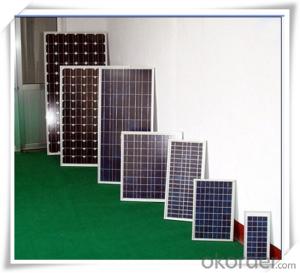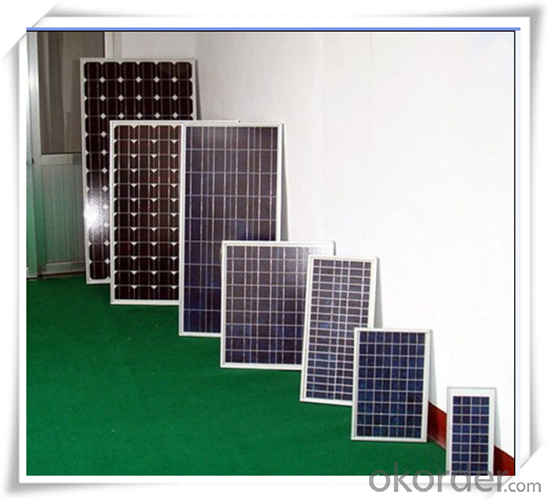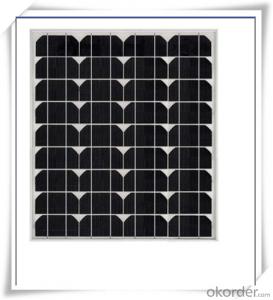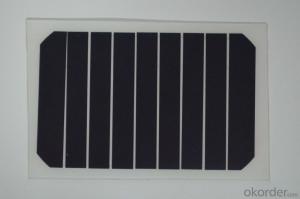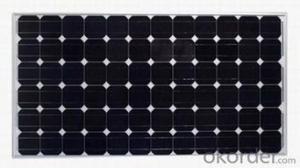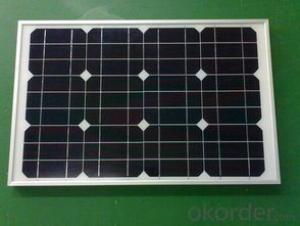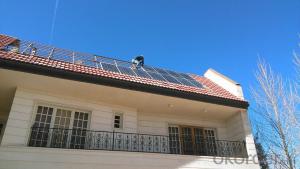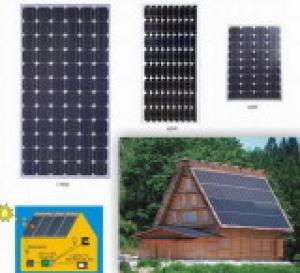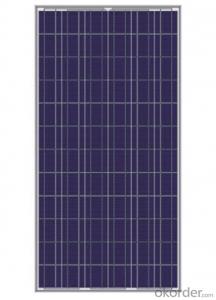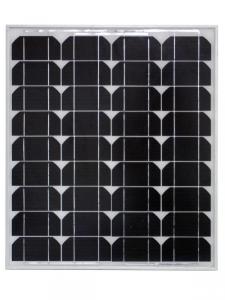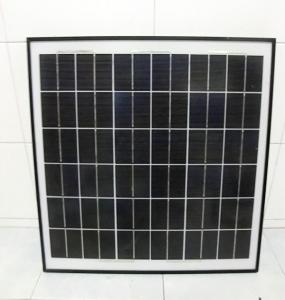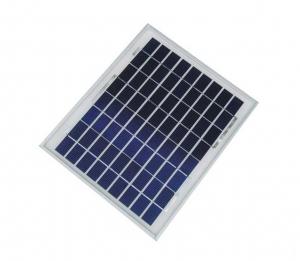Roofing Solar Panels - Monocrystalline Solar Panel from 1.5w to 300w CNBM
- Loading Port:
- Qingdao
- Payment Terms:
- TT OR LC
- Min Order Qty:
- 10 set
- Supply Capability:
- 300000 set/month
OKorder Service Pledge
OKorder Financial Service
You Might Also Like


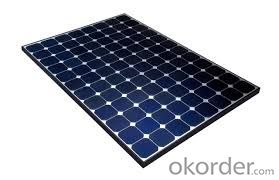
Monocrystalline Solar Modules
We offers a range of small, medium and large monocrystalline solar modules, designed for a range of requirements.
Specifications:
Tolerance | +/- 3% |
Cell | Monocrystalline silicon solar cells |
N0. of Cells | 72 (12 x 6) |
Dimension of Modules (mm) | 1581 x 809 x 40 |
Weight (kg) | 15.5 |
Limits:
Operating Temperature | -40~+85? |
Storage Temperature | -40~+85? |
Maximum System Voltage | 1000 VDC max. |
Hail Impact | Diameter of 28mm with impact speed of 86km/h |
Temperature and Coefficients:
NOCT | 48C+/-2? |
Voltage temperature coefficient (%/K) | -0.34 |
Current temperature coefficient (%/K) | 0.09 |
Power temperature coefficient (%/K) | -0.37 |
Characteristics:
Model: | SGM-160D | SGM-165D | SGM-170D |
Max-power voltage Vmp (V) | 34.5 | 35.4 | 35.8 |
Max-power current Imp (A) | 4.64 | 4.66 | 4.75 |
Open-circuit voltage Voc (V) | 41.75 | 43.6 | 43.32 |
Short-Circuit Current Isc (A) | 5.32 | 5.08 | 5.38 |
Max-power Pm(W) | 160 | 165 | 170 |
Model: | SGM-175D | SGM-180D | SGM-185D |
Max-power voltage Vmp (V) | 36.1 | 36.2 | 36.2 |
Max-power current Imp (A) | 4.85 | 4.97 | 5.11 |
Open-circuit voltage Voc (V) | 43.68 | 43.8 | 44.8 |
Short-Circuit Current Isc (A) | 5.49 | 5.48 | 5.51 |
Max-power Pm(W) | 175 | 180 | 185 |
STC: Irradiance 1000W/m2, Module temperature 25?, AM=1.5
Monocrystalline Solar Panels Specifications Range
Maximum Power (Pm) | Dimension | Weight | Operating Voltage (Vmp) | Operating Current (Imp) | Open Circuit Voltage (Voc) | Short Circuit Current (Isc) |
3W | 158x241x25mm | 0.5kg | 8.5V | 0.36A | 10.5V | 0.4A |
4W | 308x166x25mm | 0.77kg | 8.5V | 0.47A | 10.5V | 0.54A |
4W | 308.x166x25mm | 0.77kg | 16.8V | 0.24A | 21V | 0.27A |
5W | 296x215x25mm | 0.3kg | 16.8V | 0.48a | 21V | 0.54A |
10W | 286x406x25mm | 1.5kg | 16.8V | 0.59A | 21V | 0.66A |
12W | 286x406x25mm | 1.5kg | 16.8V | 0.71A | 21V | 0.8A |
14W | 286x541x25mm | 2kg | 16.8V | 0.83A | 21V | 0.96A |
16W | 286x541x25mm | 2kg | 17.2V | 0.93A | 21.5V | 0.99A |
18W | 296x541x25mm | 2.4kg | 18.8V | 1.07A | 21V | 1.2A |
20W | 296x641x25mm | 2.4kg | 17.2V | 1.15A | 21.5V | 1.24A |
24W | 541x451x25mm | 3.15kg | 16.8V | 1.14A | 21V | 1.56A |
26W | 541x451x25mm | 3.15kg | 17.2V | 1.51A | 21.5V | 1.63A |
30W | 296x966x25mm | 3.85kg | 16.8V | 1.78A | 21V | 2.03A |
36W | 541x641x35mm | 4.7kg | 16.8V | 2.14a | 21V | 2.4A |
40W | 541x641x35mm | 4.7kg | 17.2V | 2.33A | 21.5V | 2.5A |
55W | 1057x457x35mm | 6.6kg | 17.6V | 3.12A | 21.6V | 3.3A |
70W | 546x1196x35mm | 8.5kg | 16.8V | 4.15A | 21V | 4.7A |
75W | 546x1196x35mm | 8.5kg | 17.2V | 4.36A | 21.5V | 4.8A |
80W | 546x1196x35mm | 8.5kg | 17.6V | 4.55A | 21.6V | 4.9A |
110W | 1066x811x40mm | 11.8kg | 17.6V | 6.25A | 21.6V | 6.6A |
150W | 1066x811x40mm | 14kg | 34.4V | 4.36A | 43.2V | 4.7A |
- Q: i was looking into making solar panels to reduce my electric bill, but i need to know how to actually hook it up.
- nowing what to do with unused renewable electricity is always a dilemma – hooking up to the grid has to be the preferred option. If your residential home is grid tied, i.e. connected the electricity grid as opposed to off-grid and you are using solar panels to generate electricity. Then it makes a lot of sense to hook your solar panels to the grid, because instead of losing the unused electricity or having to maintain a bank of deep cycle batteries, you simply feed it back to the grid. You feed electricity back to the grid via your electric meter which measures the electricity in Kilowatt per hour. This has the effect of reversing your meter which in turn reduces your electricity bills and if you are generating a lot of electricity you could find the utility company owing you money! The Solar Powered System Therefore, your solar powered installation would look like this. The solar panel will connect to an “array disconnect” – you need an array disconnect for system maintenance because it allows you to easily shut off the power. The array disconnect is connected to an “inverter”. The solar panel generates DC power and the electricity from the grid is AC power. Therefore, you need an inverter to convert DC power to AC power. The inverter is connected to an “AC breaker panel”. This is the interface where your solar generated electricity meets the electric meter and allows you to feed electricity back to the grid. Now in most countries and states you are not allowed to tamper with the electric meter so at this point you should contact your local electricity energy supplier and ask them to supply an engineer to hook you up to the grid. If you have anything to add to this article or you have connected your system to the grid – tell us how you did it by writing a comment below.
- Q: I am building a solar panel I have wired in series 36 .5 volt solar cells to produce 8 volts I have another panel that has 34 .5 volt solar cells to produce 7 volts. Any issues with wiring these 2 arrays in Parallel? I.E. would the smaller array take usable power away from the larger array?
- The okorder /
- Q: Can solar panels be used on commercial buildings?
- Yes, solar panels can be used on commercial buildings. In fact, many businesses are embracing solar energy to reduce their carbon footprint and save on electricity costs. Installing solar panels on commercial buildings not only helps generate clean and renewable energy but also provides long-term financial benefits for businesses.
- Q: how efficient are flexible solar panels?
- I don't have a number, but in general, no one uses a flexible panel unless they are compelled to. The efficiency is lower, and my experience is that they don't last. I had one a few years ago, and it lasted less than 2 years. My rigid panels came with a 25-year performance warranty, and are still working great after 7 years.
- Q: what direction should solar panels face to get the best exposure of the sun.
- depends on the exposure.[trees other buildings, etc.] If you don't have trackers to keep the panels facing the sun , just plain old due south ,I've heard, is best for best average exposure.
- Q: What is the role of inverters in solar panel systems?
- The role of inverters in solar panel systems is to convert the direct current (DC) electricity generated by the solar panels into alternating current (AC) electricity that can be used to power household appliances and feed into the electrical grid.
- Q: How much would it cost (approximately) to convert my home (3 bed. 2 bath) to a green home that is run entirely upon solar panels on my roof? From the panels through installation does anyone know a price break down?
- You will first need to know how much power you'll be using. Follow the link I left and it will take you to a page that has an Electrical Load Computation Worksheet. It's about the fifth one down on the page. After that, you'll be able to figure out what you need and what it will cost. The page link I left has other helpful articles, too.
- Q: What is the lifespan of a solar panel?
- The lifespan of a solar panel typically ranges from 25 to 30 years, although some panels can last even longer with proper maintenance and care.
- Q: lately i have been interested in solar power. i own my own home and in Texas it's HOT, so my A/C is always on and that light bill is like $300.00 a month. i was looking at other light companies but then i remembered that there are the so called solar power but i dont knowknow to start or how it would work to power the a/c machine...pls help
- Solar panels are a great way to cut back on your energy bill. Once you are hooked up to solar energy, the home owner does absolutly nothing different than if you buy electricity from the power-company. Sinse you live in texas, it is more than likely you will not be able to use purely solar power to meet your energy needs unless you purchase a large system ($30,000+). However with enough of an investment, you can 'Sell' your energy back to the power company and greatly reduce your electric bill. I would call a licensed Solar Power company for more information if you do not know much about solar. While the system is relativally simple, it should only be designed and installed by trained licensed professionals.
- Q: how the energy of load connected to solar PV measure.?Want too the basic idea about it.The role of current flowing thrugh the load?Can u explain with example..can explain simply?Im not an electrical student so explain very basics
- A solar panel is made up of solar cells. Each cell produces about 0.5 to 0.6 volts. Cells are connected in series, like the batteries in a flashlight. Enough cells are placed in series to produce the desired voltage. Cells produce very little current, so many strings of cells are connected in parallel to produce sufficient current. The output is direct current (DC), like that from a battery. A home solar system needs alternating current (AC), so an inverter is used to change from DC to AC. Some systems have batteries for backup power. In these some of the DC output is used to keep the batteries charged. Systems are measured in kilowatts. System sizes are chosen to meet the demands for electricity. My system has a 6 kilowatt (kW) rating. The true output is more like 4. Now that you know this much you can Google SOLAR SYSTEMS to learn more.
Send your message to us
Roofing Solar Panels - Monocrystalline Solar Panel from 1.5w to 300w CNBM
- Loading Port:
- Qingdao
- Payment Terms:
- TT OR LC
- Min Order Qty:
- 10 set
- Supply Capability:
- 300000 set/month
OKorder Service Pledge
OKorder Financial Service
Similar products
Hot products
Hot Searches
Related keywords
